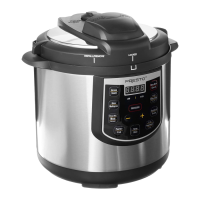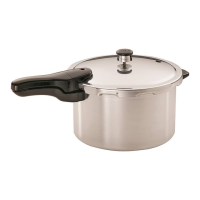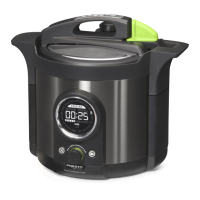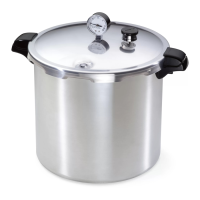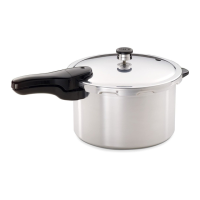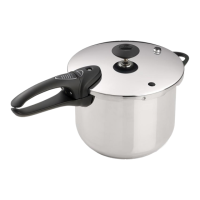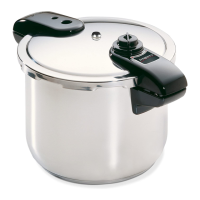5
As jars cool after processing (by either the boiling water or pressure canning method) a vacuum is formed, sealing food within and
preventing any new microorganisms from entering and spoiling the foods.
BEFORE BEGINNING
Selecting Jars
Glass home canning jars, sometimes referred to as Mason jars, are made of heat-tempered glass for durability and reuse. These are the
only jars recommended for safe home canning. They are available in standard sizes (half-pint, pint, and quart jars) and will withstand
the heat of a pressure canner. The diameter of Mason jars may vary from one manufacturer to another.
Before filling Mason jars, test load your canner. It may be necessary to double-deck pint and half-pint jars to reach the maximum capac-
ity of your canner, as indicated in the chart below. To double-deck, stagger the jars by placing one jar on top of two. However, if using
the boiling water method, do not double-deck jars. Jars may touch. The canning rack which accompanied your pressure canner must be
placed on the bottom of the canner to prevent jar breakage. Although it is not necessary to use a rack between layers of jars, if you wish
to do so, a rack can be ordered from the Presto Consumer Service Department. See page 35.
Canning Lids and Bands
The two-piece vacuum cap (lid and band) is the recommended closure for home
canning. It consists of a at metal lid with a sealing compound on the outer edge
and a separate metal screw band that secures the lid during processing. The at lid
is for one use only while the bands can be used repeatedly if they remain in good
condition. Always prepare lids and bands according to manufacturer’s instructions.
Measuring Headspace
Headspace is the air space between the top of the food or its liquid and the lid. Leaving
too much headspace can result in underprocessing because it may take too long to
release the air from the jar. Leaving too little headspace will trap food between the
jar and the lid and may result in an inadequate seal. As a general rule, allow ½-inch
headspace for fruits and tomatoes and 1-inch for vegetables, meats, poultry, and
seafood. All recipes will indicate the amount of headspace necessary for the food
being canned.
Removing Air Bubbles
After food has been packed in jars, any air bubbles must be removed. Trapped air bubbles may rise to the top during processing, causing
too much headspace. Work quickly to remove air bubbles that have become trapped between pieces of food by moving a clean, nonmetallic
spatula around the jar between the food and side of the jar.
Preparing Jar Rims and Adjusting Lids
Immediately wipe jar rims with a clean, damp cloth to remove any residue. Any food particles, such as seeds, grease, or syrup, on the
rim of the jar may prevent the jar from sealing. Place at lid on rim of jar, making sure sealing compound is touching glass. Position a
band over the lid and, using ngertips, screw onto the jar just until resistance is met. Do not overtighten as air must release from the jars
during processing and cooling.
AFTER PROCESSING
Cooling Jars
After processing, remove jars to a dry towel on countertop away from drafts. Leave 1 to 2 inches of space between jars to allow for even
cooling. Do not invert jars or cover with a cloth. Allow jars to cool naturally for 12 to 24 hours before checking the seals.
Testing Seals
After jars have cooled, test the jar lids to be sure a vacuum seal has formed. Press down on the center of the at lid to determine if it is
concave (stays down when pressed). Then remove the screw band and gently try to lift the lid with your ngertips. If the center does not
ex up and down and you cannot lift the lid off, the lid has a good seal.
Detecting Spoilage
If up-to-date instructions and processing times and pressures are followed carefully, spoilage is uncommon. However, it is still recom-
mended to check for signs of spoilage before tasting any canned food. Check for a broken seal, gassiness when opening, mold, sliminess,
cloudiness, or unpleasant odors. If any of these signs are present, discard the food. As a safeguard against using canned low-acid and
tomato products which may be affected with spoilage that is not readily detected, boil food 10 minutes for altitudes up to 1,000 feet
above sea level. Extend the boiling time by 1 minute for each 1,000 foot increase in altitude. Many times odors that cannot be detected
in the cold product will become evident by this method. If, after boiling, food does not smell or look right, discard it without tasting.
MAXIMUM JAR CAPACITIES
Regular jars Wide mouth jars
26 half-pints* 16 half-pints*
20 pints* 16 pints*
7 quarts 7 quarts
* It will be necessary to double-deck jars to achieve the
maximum capacity; see information above.
For boiling water method, do not double-deck jars.
